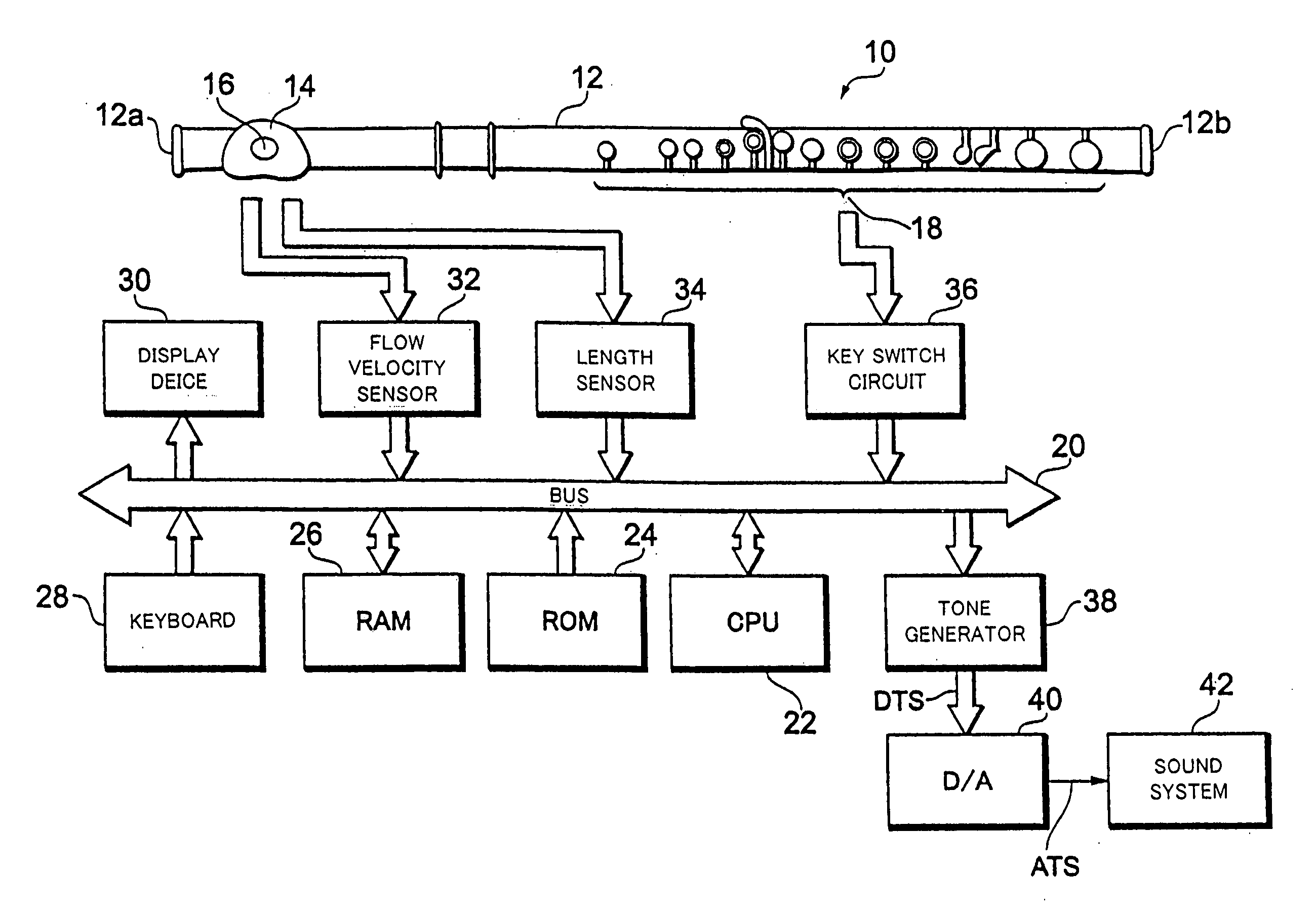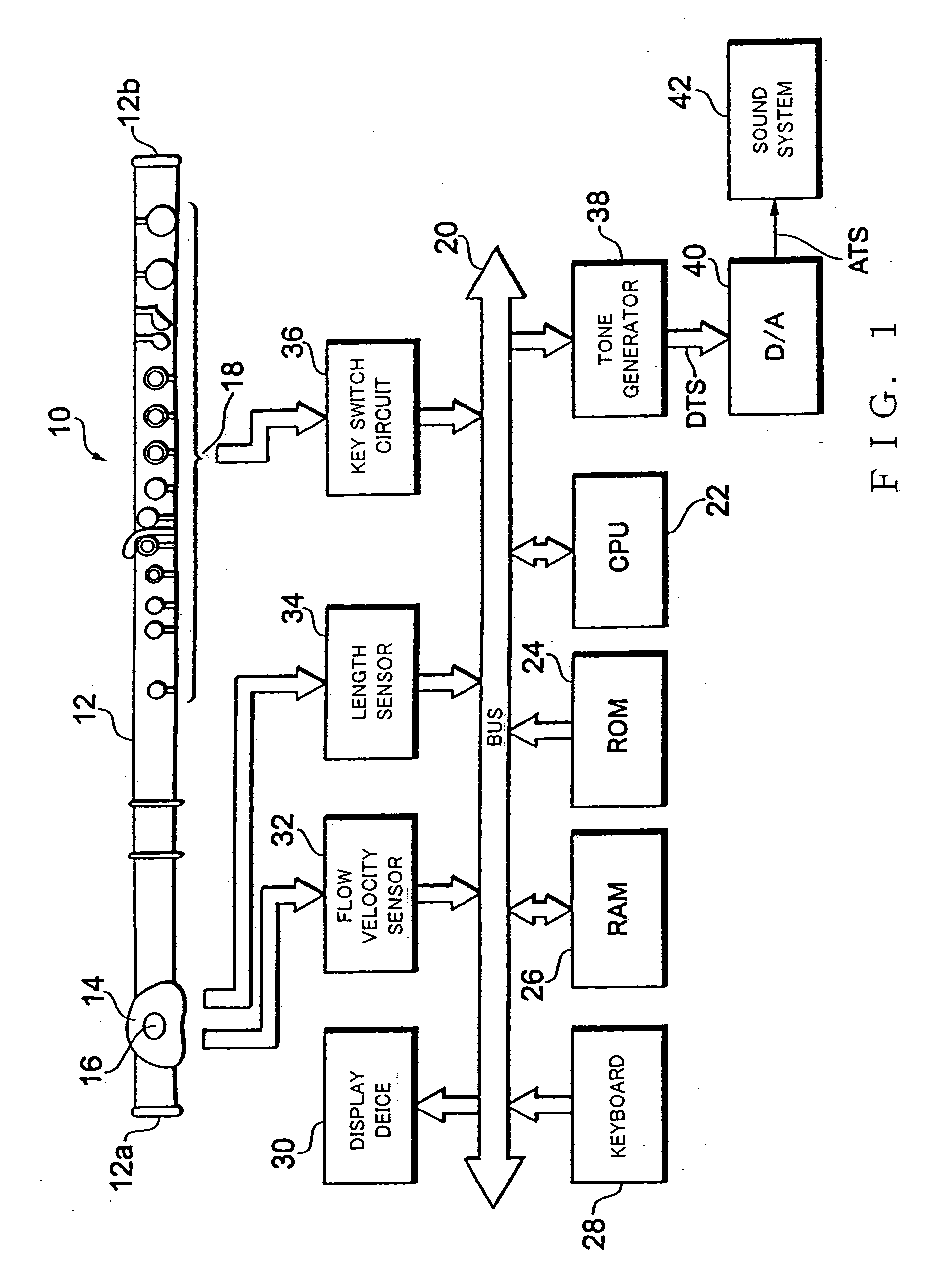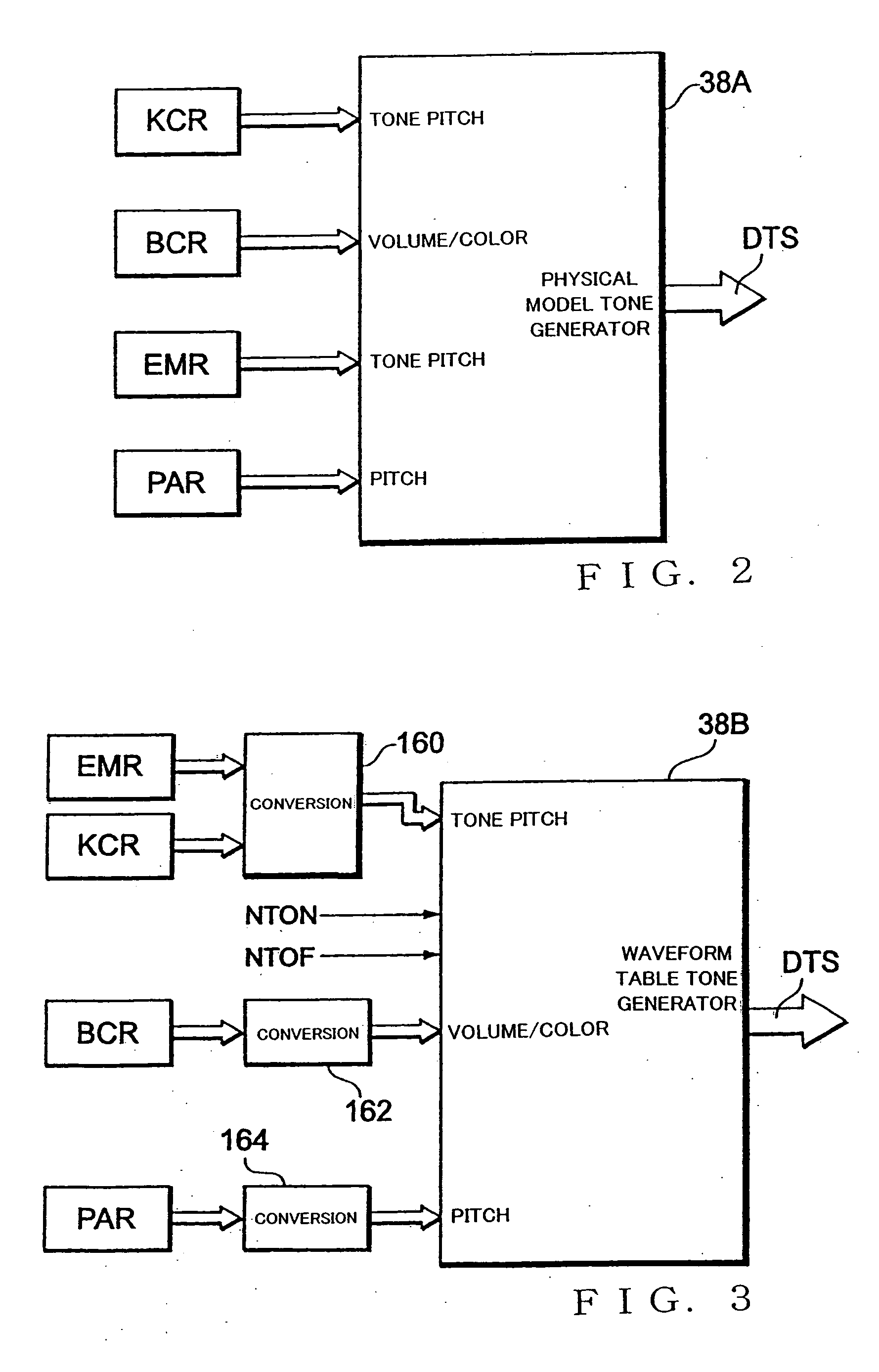[0016] In view of the foregoing, it is an object of the present invention to provide a novel tone
generator control apparatus for an electronic
wind instrument which can readily simulate octave-specific playing styles of an air-lead instrument.
[0020] According to the present invention, the jet parameter is calculated using the frequency of the tone
signal to be generated in correspondence with the detected fingering state, and thus, there is no need to acquire an actual tone generating frequency. Further, during generation of a tone
signal of a predetermined octave, the tone generating octave is raised by one octave once it is detected that the calculated jet parameter has decreased to the first predetermined value; thus, after a user or human player plays in such a manner that the jet parameter reaches the first predetermined value, a tone
signal higher in pitch by one octave can be generated with the user keeping the same playing (i.e., air-blowing) state, so that particular playing (i.e., air-blowing) operation for increasing the jet traveling angle from π / 2 to π is not required. Further, during generation of the tone signal having been raised in pitch by one octave, the tone generating octave is lowered by one octave once it is detected that the calculated jet parameter has increased to the second predetermined value greater than the first predetermined value; thus, after the user or human player plays in such a manner that the jet parameter reaches the second predetermined value, a tone signal lower in pitch by one octave can be generated with the user keeping the same playing (i.e., air-blowing) state, so that particular playing (i.e., air-blowing) operation for decreasing the jet traveling angle from 3π / 2 to 3π / 4 is not required. In this way, the present invention can readily perform octave-specific playing styles. Further, the present invention imparts a
hysteresis characteristic to the octave switching by setting the second predetermined value greater than the first predetermined value. Therefore, no octave change occurs as the human player plays in such a manner as to slightly change the pitch as long as the change is within a range where the jet parameter does not reach the first predetermined value (when the pitch is to be raised by one octave) or within a range where the jet parameter does not reach the second predetermined value (when the pitch is to be lowered by one octave); thus, the present invention permits various rendition styles, such as a pitch bend and vibrato. As a result, the tone
generator control apparatus according to the first aspect of the present invention can properly deal with embouchures of various
flute-performing methods and therefore suits users who want to enjoy playing that is close to playing of a
flute.
[0022] The tone generator control apparatus according to the first aspect of the invention may further comprise: a fourth control section that, during generation, by the tone generator section, of the tone signal of the predetermined octave, controls the tone generator section to gradually raise the frequency of the tone signal as the jet parameter calculated by the calculation section decreases toward the first predetermined value, and a fifth control section that, during generation, by the tone generator section, of the tone signal of the pitch having been raised by one octave, controls the tone generator section to gradually raise the frequency of the tone signal as the jet parameter calculated by the calculation section increases toward the second predetermined value. With such arrangements, it is possible to simulate slow variation in tone generating frequency before and after an octave change in an actual air-lead instrument. Thus, the user or human player can feel a sign of an octave change and thereby smoothly perform octave-specific playing.
[0025] Namely, in the tone generator control apparatus according to the second aspect of the present invention, once the distance between the jet blowout outlet and the edge has decreased to the predetermined value during generation, by the tone generator section, of the tone signal of the predetermined octave, the tone generating octave is raised by one octave, while, once the distance between the jet blowout outlet and the edge has increased above the predetermined value during generation, by the tone generator section, of the tone signal having been raised in pitch by one octave, the tone generating octave is lowered by one octave. Thus, the present invention permits octave-specific playing by only changing the lip-to-edge distance and therefore is very suitable for beginners. With the above-described tone generator control apparatus according to the first aspect of the invention, the user is allowed to enjoy playing close to playing of a flute; however, it is difficult to execute a performance in great tone volume in a low
pitch range because there is a tendency that no tone is generated unless the
jet flow velocity is reduced, and it is difficult to execute a performance in small tone volume in a
high pitch range because there is a tendency that no tone is generated unless the jet flow velocity is increased. However, with the above-described tone generator control apparatus according to the second aspect of the present invention, where the octave-switching control is performed using the distance between the jet blowout outlet and the edge rather than the jet parameter, such as the jet traveling angle, it is possible to execute not only a performance in great volume in a low
pitch range but also a performance in small tone volume in a
high pitch range.
[0027] With the octave-switching control performed on the basis of the current tone generating state and jet parameter as stated above, the tone generator control apparatus of the present invention can accomplish the advantageous benefit that octave-specific playing styles of an air-lead instrument, such as a flute, can be appropriately simulated with an utmost ease. Further, with the octave-switching control performed on the basis of the current tone generating state and jet-blowout-outlet-to-edge distance as stated above, the tone generator control apparatus of the present invention advantageously permits not only octave-specific playing but also a performance in great volume in a low
pitch range and a performance in small volume in a
high pitch range, by only changing the lip-to-edge distance.
 Login to View More
Login to View More  Login to View More
Login to View More 


